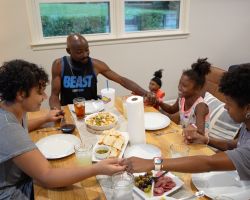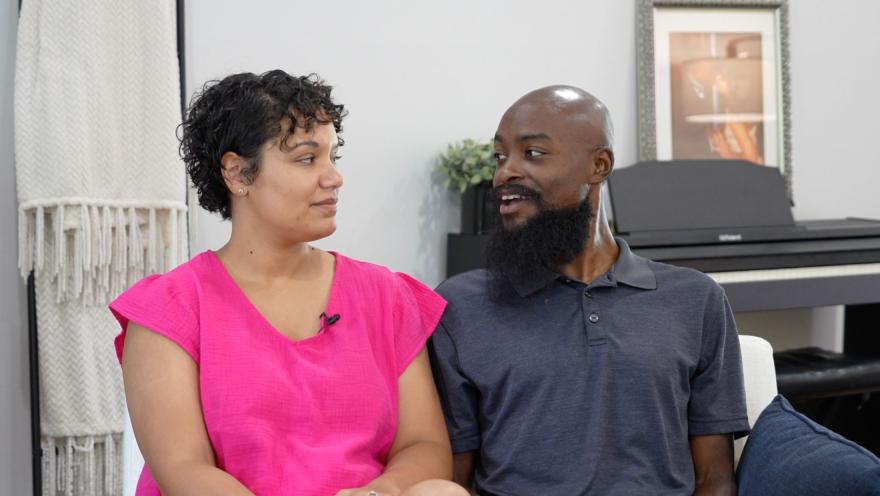Today is Rare Disease Day, an event that takes place worldwide, typically on the last day of February each year, to help raise awareness among policymakers and the public about rare diseases and their impact on patients’ lives. In recognition today, Kristina shares what it’s like to be a ALS caregiver for her husband, Lamar, and her unique perspective on the rarity of ALS.
By Kristina Woody
Hello ALS community!

For being the shortest month of the year, February is quite a month of holidays and notable observances. For instance, Valentine’s Day, President’s Day, Random Acts of Kindness Day, International Day of Women & Girls in Science. Did you know about Pizza Day or Public Sleeping Day? February is also recognized as American Heart Month and Black History Month, while Carnival is being celebrated in Brazil. There is so much to celebrate just in this short list alone!
There are a couple days of recognition that are of particular importance in OUR community. First is National Caregiver’s Day, observed on the 3rd Friday of February, which serves to honor both health care professionals in the home health and hospice settings, as well as family members (or other non-professional individuals) providing physical and emotional care for others.
I can imagine there are numerous individuals we can thank for their efforts in providing the essential care services needed to make ALS more manageable. Or maybe you are a primary caregiver, and you most definitely need to give yourself praise for the continued patience, compassion, dedication and empathy you are pouring out for your loved one. It’s not an easy task!
Another day of importance is today, Rare Disease Day. With a prevalence rate (number of people living with disease) of approximately 4-6 out of 100,000 people, ALS is statistically identified as a rare disease. In the first four years of receiving the news of my husband Lamar’s diagnosis, we journeyed through a new way of life feeling most often isolated.
In the last couple years, since sharing our story publicly with the ALS Association and local media, our eyes have been opened wide to the realization that rarity is only stats and percentages. Within just weeks of our media content being shared, we met families in our very own community living with ALS. One family living less than one mile away, on our street! We have been able to connect with advocates, caregivers and patients across multiple states and around the world, virtually and in-person.
What feels rare in the ALS journey specifically is to mourn daily, unremitting loss while living for hope. There is no cure and limited treatment available. As a nurse and wife walking through constant transition to accommodate for my husband’s ever-changing needs, it feels like a journey many outside this community struggle to understand. There is a uniqueness in care management, time effectiveness, and determination of quality of life for ALS patients. The distinctiveness of those aspects makes ALS all the rarer.
National and world-wide organizations will be promoting forums and events to raise awareness of rare diseases in our population. I encourage you to join any of these events to learn more about how medical practice and policy is being advanced to support those living with rare diseases, including ALS. The following link is one of the many events happening for Rare Disease Day through the National Institute of Health (NIH). The event is free, open to the public and will be archived for replay.
Rare Disease Day at NIH
I wanted to share a snippet of content from the NIH event registration page that I believe emphasizes the necessity of support for rare diseases such as ALS.
“Progress in data science and an increased understanding of disease genetics lead experts to agree that more than an estimated 10,000 rare diseases are affecting about 30 million people in the United States. Most of these people are children. In all, nearly 10% of the U.S. population have a rare disease. Rare diseases often are difficult to diagnose—it can take years. Even after an accurate diagnosis, treatment often is not available because fewer than 500 rare diseases have FDA-approved treatments. Research led by NCATS [National Center for Advancing Translational Sciences] suggests that nationwide medical costs for individuals with rare diseases are likely as high as those faced by people with common diseases, such as cancer and heart failure.”
While the patient population of people living with rare diseases is fewer in number, they are not the exception. Quality of life through accessibility of all resources is a standard of care no matter the condition.
Stay encouraged in your pursuit for change & hopeful for more good days than not.
Blessings,
K.W.
Special thanks to Kristina and Lamar for allowing us to share their personal ALS journey with the community. If you would like to read more about the Woody family, visit our website here.
To continue to follow stories about people living with ALS in the community or learn more about the disease, subscribe to receive our weekly blogs in your inbox HERE or follow us at als.org/blog.


Join the conversation. Please comment below.